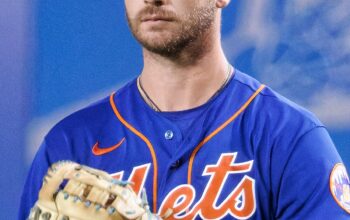\NEW YORK Rival team evaluators praised David Stearns, the president of baseball operations of the New York Mets, for maintaining discipline in a star-light trade market, even if they saw the club’s signings as only incremental upgrades.
The prospect cost for the few high-impact players who looked to be available at the trade deadline was characterized as “aggressive” by a number of industry experts, including Stearns. In his October press conference, Stearns declared his intention to make the playoffs in 2024 and his want to do it without jeopardizing his future. After the trade deadline, the Mets (57-51) are 1/2 game off of the last wild-card berth.
“What’s funny is I was reading up on (the Mets’) trades and thought to myself, ‘This is the reason Stearns was hired,’” a rival scout said. “Very measured and no panic to make the big splash. He has stayed true to his vision and to what he believes is his timeline. It could have been very easy for him to go to (owner Steve Cohen) and request money for someone like Blake Snell, assuming the $30 million next year, but that would also mean giving up prospects which he was not willing to do, obviously.
“I think the guys he got are marginal upgrades, but the guys he gave up won’t come back to bite him and he has powder dry for this offseason when I expect more moves from him.”
The Mets added to their roster without dealing any of their best prospects, as The Athletic reported last week. They added right-handed starting pitcher Paul Blackburn; left-handed batting outfielder Jesse Winker; and right-handed relievers Phil Maton, Ryne Stanek, Huascar Brazobán, and Tyler Zuber. To what extent do they improve the Mets?
The Mets were able to get assistance when they were weak. Following the injuries to Christian Scott and Kodai Senga, they particularly wanted to strengthen their bullpen and recruit a starting pitcher. Their predicament in right field, where they are without Starling Marte (knee) and were receiving nothing from left-handed batter DJ Stewart, who has since been optioned to Triple A, was improved by adding a reliable left-handed bat in Winker.
Within a market that placed a high value on relief help, scouts and executives liked the idea of adding veterans Maton and Stanek for relatively little money (they will send cash or a player to be named later to the Tampa Bay Rays for Maton while taking on his salary, and they moved minor-league outfielder Rhylan Thomas for Stanek). Given the price, it would have been unexpected for the Mets to sign one of the top rental relievers, as The Athletic predicted last week. The decision to sign Stanek and Maton should assist, according to evaluators, as both players have demonstrated in the past that they are capable of taking the lead in relief on a competitive team.
Scouts had high expectations for Brazobán (2.84 ERA, 31 2/3 innings), who the Mets traded minor-league utility infielder Wilfredo Lara to the Miami Marlins to acquire. Brazobán, 34, was characterized by one assessor as a “late bloomer who has improved a lot in the last two years.” Another evaluator called Brazobán’s changeup a “plus-plus pitch.”
Some assessors were concerned about Brazobán’s age and lack of experience, and they did not think he would be a significant impact reliever. But if the Mets help him learn which pitches to use when, one said he could develop into a premier leverage reliever. An executive speculated that Brazobán, with his sinker/changeup combo, at the very least, sets the stage for the Mets’ middle innings.
For evaluators, Zuber is a wild card. One person said Zuber’s stuff “jumps off the page,” but there’s no telling what to expect from a 29-year-old who has logged just 3 1/3 innings in the majors since 2021 while spending a brief period in an independent league. Scouts cited command issues, but said Zuber can get right-handed batters out with his low-slot delivery. In the context of relievers sometimes emerging out of seemingly nowhere, one person said, “It’s not crazy to think he can be something, if not really good.”
Regarding Blackburn (4.41 ERA in 51 innings in 2024; 4.83 ERA throughout his eight-year career), analysts had differing opinions. All they said was, “I am out on him.” Another described the veteran as a strike-thrower with quantity over quality in his material, a “very great back-of-the-rotation piece for a playoff squad.” Blackburn is a “strong competitor” who shows concern, according to several sources.
Although Luis Severino, Jose Quintana, and Sean Manaea have all pitched effectively together, the Mets lack a true top starter, so they needed to add someone to at least assist cover innings in the case of Blackburn, 30. Blackburn has club control until the 2020–21 season, which means the Mets will need to replace some holes in their rotation by then. Blackburn is a “good innings-eater” and a “overachiever in the back end,” at most, according to evaluators. That may be useful, but it is not really fascinating.
Hence why when asked about Blackburn, one person replied with a yawn emoji.
Another said Blackburn was “a Kyle Hendricks type.”
Winker, though, drew some exclamation points. As one evaluator said, “Winker gives them someone who can really have a quality at-bat against relief pitching — yes!” Although Winker has played in right field for just 21 1/3 innings since 2022, scouts detested his defense and doubted his suitability there. They did, however, like how the 30-year-old maintained his characteristics as a hitter who gets on base and does not chase, while also increasing his speed and conditioning. This has allowed him to have a successful season overall (.792 OPS, 11 home runs, and 14 stolen bases).
Scouts believe right-hander Kade Morris to be the best of the group of prospects that the Mets dealt. In exchange for Blackburn, the Mets sent Morris to the Oakland Athletics. Tyler Stuart, a right-hander who was traded for Winker by the Mets, had the highest ranking of all 89 prospects listed by Baseball America before the deadline, at 35. Morris was forty-one, and the next three were Lara (86), outfielder Rhylan Thomas (82) and right-hander Paul Gervase (75). Keith Law’s preseason top 20 prospects included Lara as the lone player dealt. Morris, who was selected by the Mets in the third round of the 2023 draft, was the one that scouts loved the most because they thought he might be a major league starting pitcher.
But as one executive said, “In what was a sellers’ market, as a team trying to make the playoffs, you should take that price and be fine with it.”
(Photo of Huascar Brazobán: Jim McIsaac / Getty Images)


